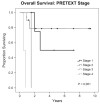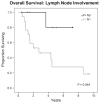Prognostic factors in fibrolamellar hepatocellular carcinoma in young people
- PMID: 25598114
- PMCID: PMC4558902
- DOI: 10.1016/j.jpedsurg.2014.10.039
Prognostic factors in fibrolamellar hepatocellular carcinoma in young people
Abstract
Background/purpose: Fibrolamellar hepatocellular carcinoma (FL-HCC) arises in pediatric/adolescent patients without cirrhosis. We retrospectively evaluated the impact of resection, nodal status, metastasis, and PRETEXT stage on overall survival (OS).
Methods: With IRB approval, we reviewed records of 25 consecutive pediatric patients with FL-HCC treated at our institution from 1981 to 2011. We evaluated associations between OS and PRETEXT stage, nodal involvement, metastasis, and complete resection.
Results: Median age at diagnosis was 17.1years (range, 11.6-20.5). Median follow-up was 2.74years (range, 5-9.5). Five (28%) patients had PRETEXT stage 1 disease, 10 (56%) had stage 2, 2 (11%) had stage 3, and 2 (11%) had stage 4 disease. On presentation, 17 (68%) patients had N1 disease, and 7 (28%) had parenchymal metastases. Complete resection was achieved in 17 (80.9%) of 21 patients who underwent resection. Five-year OS was 42.6%. Survival was positively associated with complete resection (P =0.003), negative regional lymph nodes (P =0.044), and lower PRETEXT stage (P <0.001), with a trend for metastatic disease (P =0.05).
Conclusions: In young patients with FL-HCC, lower PRETEXT stage and complete resection correlated with prolonged survival, while metastatic disease and positive lymph node status were associated with poor prognosis. Thus, we recommend complete resection and regional lymphadenectomy whenever possible.
Keywords: Adolescent; Fibrolamellar; Hepatocellular carcinoma; Pediatric; Prognostic.
Copyright © 2015 Elsevier Inc. All rights reserved.
Figures




References
-
- Weeda VB, Murawski M, McCabe AJ, Maibach R, Brugières L, Roebuck D, et al. Fibrolamellar variant of hepatocellular carcinoma does not have a better survival than conventional hepatocellular carcinoma-- Results and treatment recommendations from the Childhood Liver Tumour Strategy Group (SIOPEL) experience. Eur J Cancer. 2013;49:2698–704. - PubMed
-
- MacKinlay GA, Pritchard J. A common language for childhood liver tumours. Pediatr Surg Int. 1992;7:325–6.
-
- El-Serag HB, Davila JA. Is Fibrolamellar Carcinoma Different from Hepatocellular Carcinoma? A US Population-Based Study. Hepatology. 2004;39:798–803. - PubMed
-
- Edmondson HA. Differential diagnosis of tumors and tumor-like lesions of liver in infancy and childhood. AMA J Dis Child. 1956;91:168–86. - PubMed
MeSH terms
Supplementary concepts
Grants and funding
LinkOut - more resources
Full Text Sources
Other Literature Sources
Medical

